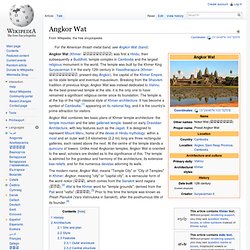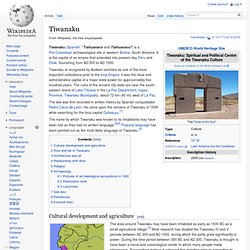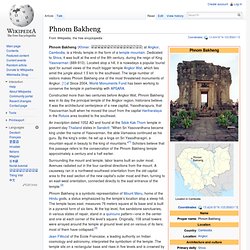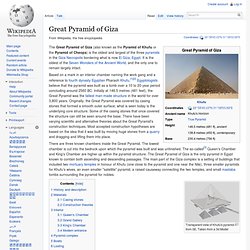

List of archaeoastronomical sites by country - Wikipedia, the fr. This is a list of sites where claims for the use of archaeoastronomy have been made, sorted by country.

Clive Ruggles and Michel Cotte recently edited a book on heritage sites of astronomy and archaeoastronomy that provides a list of the main archaeoastronomical sites around the world.[1] Australia[edit] Ngaut Ngaut oral tradition says these engravings represent lunar cycles.[2]Wurdi Youang, a stone arrangement with possible solar alignments[3] Bangladesh[edit] Brazil[edit] Bulgaria[edit] Cambodia[edit] Canada[edit] Colombia[edit] El Infiernito, (Spanish for "Little hell"), is a pre-Columbian Muisca site located at the outskirts of Villa de Leyva, Boyacá Department, Colombia. China[edit] Puyang tomb, dated from 5000 BP, depicts a mosaic of constellations.[6]
Carnac. Carnac (Breton: Karnag) is a commune beside the Gulf of Morbihan on the south coast of Brittany in the Morbihan department in north-western France.

Its inhabitants are called Carnacois. Carnac is renowned for the Carnac stones – one of the most extensive Neolithic menhir collections in the world – as well as its beaches, which are popular with tourists. Located on a narrow peninsula halfway between the medieval town Vannes and the seaside resort Quiberon, Carnac is split into two centres - Carnac-Ville and Carnac-Plage (the beachfront). In total there are five beaches, including la Grande Plage, and further to the east, Plage Men Dû and Beaumer. Standing stones[edit] Angkor Wat. Angkor Wat (Khmer: អង្គរវត្ត) was first a Hindu, then subsequently a Buddhist, temple complex in Cambodia and the largest religious monument in the world.

The temple was built by the Khmer King Suryavarman II in the early 12th century in Yasodharapura (Khmer: យសោធរបុរៈ, present-day Angkor), the capital of the Khmer Empire, as his state temple and eventual mausoleum. Breaking from the Shaivism tradition of previous kings, Angkor Wat was instead dedicated to Vishnu.
As the best-preserved temple at the site, it is the only one to have remained a significant religious center since its foundation. Angkor Wat. Sunrise at Angkor Wat (Enlarge) There are two great complexes of ancient temples in Southeast Asia, one at Bagan in Burma, the other at Angkor in Cambodia.

The temples of Angkor, built by the Khmer civilization between 802 and 1220 AD, represent one of humankind's most astonishing and enduring architectural achievements. From Angkor the Khmer kings ruled over a vast domain that reached from Vietnam to China to the Bay of Bengal. The structures one sees at Angkor today, more than 100 stone temples in all, are the surviving remains of a grand religious, social and administrative metropolis whose other buildings - palaces, public buildings, and houses - were built of wood and have long since decayed and disappeared.
Conventional theories presume the lands where Angkor stands were chosen as a settlement site because of their strategic military position and agricultural potential. Khmer (Angkor) Temples: Phnom Bakheng. Amazon Stonehenge. Detail of Cromlech of Calcoene Amazon Stonehenge or Calçoene megalithic observatory (also refeered to as AP-CA-18) is megalithic structure located in Amapa state, Brazil, near the city of Calçoene.

It consists of 127 blocks of granite, each up to 4 meters tall, standing upright in a circle measuring over 30 meters in diameter at the bank of the Rego Grande river on a hilltop. Archaeologists believe that this site was built by indigenous peoples for astronomical, ceremonial, or burial purposes, and likely a combination. The function of this megalithic site is unknown, much like other sites such as Stonehenge, a much older site in Great Britain. Discovery[edit] Amazon Stonehenge suggests advanced ancient rainforest culture. Amazon Stonehenge suggests advanced ancient rainforest culture By Rhett Butler, mongabay.com May 14, 2006 (modified from an earlier article) The discovery of an ancient astrological observatory in Brazil lends support to the theory that the Amazon rainforest was once home to advanced cultures and large sedentary populations of people.
Besides the well-known empires of the Inca and their predecessors, millions of people once lived in the forests and shaped the environment to suit their own needs. Archaeologists with the Amapa Institute of Scientific and Technological Research said they uncovered the ruins near Calcoene, 390 kilometers (240 miles) from Macapa, the capital of Amapa state, near Brazil's border with French Guyana.
"Only a society with a complex culture could have built such a monument," archaeologist Mariana Petry Cabral, of the Amapa Institute of Scientific and Technological Research (IEPA), told O Globo newspaper in Brazil. According to a report from AFP, Another ‘Stonehenge’ discovered in Amazon - Science. SAO PAULO, Brazil — A grouping of granite blocks along a grassy Amazon hilltop may be the vestiges of a centuries-old astronomical observatory — a find that archaeologists say shows early rainforest inhabitants were more sophisticated than previously believed.

The 127 blocks, some as high as 9 feet (2.75 meters) tall, are spaced at regular intervals around the hill, like a crown 100 feet (30 meters) in diameter. On the shortest day of the year — Dec. 21 — the shadow of one of the blocks disappears when the sun is directly above it. "It is this block's alignment with the winter solstice that leads us to believe the site was once an astronomical observatory," said Mariana Petry Cabral, an archaeologist at the Amapa State Scientific and Technical Research Institute. Amazon Stonehenge. Metsamor site. Standing stones at the ruins of the Metsamor site Metsamor Site, is the remains of the "Metsamor Castle" located to the southwest of the Armenian village of Taronik, in the Armavir Province.
It has been populated from the 5th millennium BC until the 18th century AD. The excavations of the tombs of Metsamor Castle began in 1965. The site is noted for its observatory and temple complexes consisted of seven sanctuaries. Neolithic stone circles dating back to ca. 5000 BC stand within the historical site, interpreted by enthusiasts of archaeoastronomy as an astronomical "observatory".
Metsamor Civilization and Kar Hunge. Metsamor. Zorats Karer. Zorats Karer (Armenian: Զորաց Քարեր, locally Դիք-դիք քարեր Dik-dik karer),[1] also called Karahunj, Qarahunj or Carahunge and Carenish (Armenian: Քարահունջ և Քարենիշ) is a prehistoric archaeological site near the town of Sisian in the Syunik Province of Armenia.

The phrase Zorats Karer is literally translated from Armenian as Army Stones. It is also often referred to in international tourist lore as the 'Armenian Stonehenge.'[2] §Location[edit] Zorats Karer. Tiwanaku. Coordinates: 16°33′17″S 68°40′24″W / 16.55472°S 68.67333°W / -16.55472; -68.67333 Tiwanaku (Spanish: ''Tiahuanaco and Tiahuanacu'') is a Pre-Columbian archaeological site in western Bolivia, South America.

It is the capital of an empire that extended into present-day Peru and Chile, flourishing from AD 300 to AD 1000. Tiwanaku is recognized by Andean scholars as one of the most important civilizations prior to the Inca Empire; it was the ritual and administrative capital of a major state power for approximately five hundred years. Tiwanaku.
Tiwanaku, Photo Gallery and Articles. By E. George Squier, New York, Harper and Brothers, 1877. Digging for the Truth: Angkor Wat - Part 1. Digging for the Truth: Angkor Wat - Part 2. Digging for the Truth: Angkor Wat - Part 3. Digging for the Truth: Angkor Wat - Part 4. Digging for the Truth: Angkor Wat - Part 5. Angkor Wat BBC Documentary Description Video Siem Reip. Angkor Wat. Phnom Bakheng. Phnom Bakheng (Khmer: ប្រាសាទភ្នំបាខែង) at Angkor, Cambodia, is a Hindu temple in the form of a temple mountain.

Phnom Bakheng. Cambodia: SEE CAMBODIA BEFORE YOU DIE (1of5) [EN] Cambodia: SEE CAMBODIA BEFORE YOU DIE (2of5) [EN] Cambodia: SEE CAMBODIA BEFORE YOU DIE (3of5) [EN] Cambodia: SEE CAMBODIA BEFORE YOU DIE (4of5) [EN] Cambodia: SEE CAMBODIA BEFORE YOU DIE (5of5) [EN] Great Pyramid of Giza. The Great Pyramid of Giza (also known as the Pyramid of Khufu or the Pyramid of Cheops) is the oldest and largest of the three pyramids in the Giza Necropolis bordering what is now El Giza, Egypt.

It is the oldest of the Seven Wonders of the Ancient World, and the only one to remain largely intact. Based on a mark in an interior chamber naming the work gang and a reference to fourth dynasty Egyptian Pharaoh Khufu,[1][2] Egyptologists believe that the pyramid was built as a tomb over a 10 to 20-year period concluding around 2560 BC. Initially at 146.5 metres (481 feet), the Great Pyramid was the tallest man-made structure in the world for over 3,800 years. Originally, the Great Pyramid was covered by casing stones that formed a smooth outer surface; what is seen today is the underlying core structure. Great Pyramid of Giza. The Occult Geomancy and ley lines of The Great Pyramid of Giza, Abu Simbel temples. The Abu Simbel temples are two massive rock temples in Abu Simbel (أبو سمبل in Arabic) in Nubia, southern Egypt. They are situated on the western bank of Lake Nasser, about 230 km southwest of Aswan (about 300 km by road).
The complex is part of the UNESCO World Heritage Site known as the "Nubian Monuments,"[1] which run from Abu Simbel downriver to Philae (near Aswan). The twin temples were originally carved out of the mountainside during the reign of Pharaoh Ramesses II in the 13th century BCE, as a lasting monument to himself and his queen Nefertari, to commemorate his alleged victory at the Battle of Kadesh. However, the complex was relocated in its entirety in 1968, on an artificial hill made from a domed structure, high above the Aswan High Dam reservoir. Abu Simbel temples. Sacred Places: Abu Simbel, Egypt.
An exploration of how and why places become invested with SACREDNESS and how the SACRED is embodied or made manifest through ART and ARCHITECTURE In 1257 BCE, Pharaoh Ramses II (1279-13 BCE) had two temples carved out of solid rock at a site on the west bank of the Nile south of Aswan in the land of Nubia and known today as Abu Simbel. Long before Ramses II, the site had been sacred to Hathor of Absek. Egypt - Luxor, Abu Simbel, Aswan - Part 1 of 2 - HD 720p. Egypt - Luxor, Abu Simbel, Aswan - Part 2 of 2 - HD 720p. Carnac Stones. Carnac. The Monsters of Carnac. Nabta Playa. Note approximate location circled near bottom. Early history[edit] Nabta Playa calendar in Aswan Nubia museum. Nabta Playa (Egypt) Untitled. Nabta Playa.
Nabta Playa Complex Pt1. Nabta Playa Complex Pt2. Goseck circle. Goseck circle. Goseck circle. Sonnenobservatorium Goseck. Copán. Copán. Copan Ruins. Hieroglyphs and History at Copán. Copyright © 1996 David Stuart. Ruinas de Copán - Honduras. 2007 Copan Honduras. Borobudur. Borobudur, or Barabudur, is a 9th-century Mahayana Buddhist Temple in Magelang, Central Java, Indonesia.
The monument consists of six square platforms topped by three circular platforms and is decorated with 2,672 relief panels and 504 Buddha statues.[1] A main dome, located at the center of the top platform, is surrounded by 72 Buddha statues seated inside a perforated stupa. Borobudur Temple Compounds. Borobudur Temple Compounds This famous Buddhist temple, dating from the 8th and 9th centuries, is located in central Java. It was built in three tiers: a pyramidal base with five concentric square terraces, the trunk of a cone with three circular platforms and, at the top, a monumental stupa. The walls and balustrades are decorated with fine low reliefs, covering a total surface area of 2,500 m2. Buddhist Cosmology: The Borobudur Temple Compound. Welcome to Borobudur.tv. Borobodur, The Lost Temple of Java part 1 of 2. Borobodur, the Lost Temple of Java part 2 of 2. Yantra Mantra. India 2008 - Jantar Mantar. Ram yantra, Jantar Mantar, Delhi Observatory.
Persepolis. Persepolis. Persepolis Recreated - Part (1 of 5) English version. Persepolis Recreated-Part (2 of 5) English version. Persepolis Recreated-Part (3 of 5) English version. Persepolis Recreated-Part (4 of 5) English version. Persepolis Recreated-Part (5 of 5) English version. Naqsh-e Rustam. Iran Naqsh e Rustam. Naqsh E Rostam. Naqsh-e Rostam, Shiraz. NAQSH-e RUSTAM - (The Circle of Ancient Iranian Studies - CAIS)© Brú na Bóinne. Br na B inne. Bru na Boinne: Monument to Immortality. Newgrange (Chapter 2) Clannad ~ Newgrange. Brú na Bóinne Visitor Centre Newgrange and Kno. Brú Na Bóinne Archaeological Park. Newgrange.